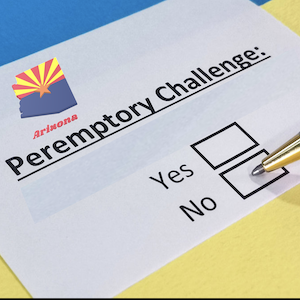By Dr. Ken Broda Bahm:

In my last post, I wrote about how the state of Arizona has been a leader in testing options for online trials. That same day, however, Arizona became the first state to eliminate peremptory strikes in criminal and civil cases. So far, the media is covering the move as a bold stroke against institutional racism. Ultimately, however, I believe the prohibition is well-intentioned but flawed. It is true that minorities are often under-represented on juries, and also true that the resulting lack of diversity has an effect on deliberations. Further, it is true that the solution to race-based strikes, the Batson standard, is an imperfect remedy. The problem is that Arizona’s fix is enormously overbroad and will target a huge swath of cases where race-based strikes simply are not an issue.
The public message should start with an accurate understanding of how peremptory strikes are generally used. When explaining peremptory strikes to their readers, the current media stories often say that a peremptory strike is often based on a “hunch” or a “gut feeling.” In practice, that is quite an oversimplification of the proper use of a peremptory strike. In my experience, strikes are used to deal with potential jurors who are — on rational and sometimes highly- documented grounds — likely to carry a bias against one side or the other, and where a cause challenge is an unavailable remedy. While it is certainly possible that Arizona and other states looking at limiting or abolishing the peremptory strike will expand challenges for cause, that will remain a flawed solution as long as judges and courtroom norms essentially require a confession of unalterable bias from prospective jurors before they can be excused. In this post, I will share my thoughts on what peremptory strikes are for and why Arizona is making a practical mistake by eliminating them.
Improper Use: Demographics are a Terrible Proxy for Attitudes
There is research to support the idea that some attorneys, particularly prosecutors, will use race as a way to tailor their juries. But why do they do that? Likely, it is because they believe that members of racial minorities are more likely to harbor anti-police and anti-prosecutor attitudes. So when race is factored in, it is really a proxy for those attitudes. Why not just look at the attitudes? Because it takes a fair amount of time and effort to dig into those attitudes – you need extended and strategic attorney-conducted voir dire, and ideally, you need a well-designed survey. While some attorneys might have a baked-in habit of relying on the shortcut of looking at the panel, I would wager that just about any attorney would rather have better and more specific information. Race-based strikes are the ugly outgrowth of truncated voir dire, and when attorneys have little other than demographics to base their strikes on, that’s what they’ll use. The solution is to continue to penalize race-based strikes, but to also improve the conditions for voir dire on the attitudes and experiences that serve as a better and more legal basis for a strike.
Proper Use: Not All Bias Rises to the Level of a Cause Challenge
Some critics of the peremptory strike will say, “If there truly is a proper basis for a strike, then why not use a challenge for cause?” The apparent belief is that the only reason you would want to strike without giving reason is if the real reason is improper. That logic, however, does not square with the human phenomena of bias, or the practical operation of a courtroom. As long as psychology continues to make our awareness of our own biases incomplete, and as long as courts continue to follow the standard modes of operation in considering and making challenges for cause — which, in practice, generally means a potential juror saying, “I can’t be fair” — then there is guaranteed to be a very wide spectrum of bias that is not addressed by the cause challenge. Not only could jurors motivated to be on the jury cynically refuse to give those magic words, but they could also simply not appreciate the extent of their own biases, or exaggerate their ability to control or “set aside” that bias. You see that in, literally, every jury selection. The research shows that one of our biggest biases is a blind spot when it comes to awareness, acknowledgment, and control of all of our other biases. When a party uses a strike to address the likelihood of actual bias, based upon its own judgment and research, that party is fulfilling the purpose of the peremptory strike in a way that cannot be addressed through a cause challenge. That makes the resulting trial more fair.
In the coming weeks and months, let’s hope that Arizona reconsiders, and other states do not follow their example.
Other Posts on Peremptory Strikes:
- Race-based Strikes: Expect Fixes for the Problem (and Problems with the Fixes)
- Be Prepared to Explain Your Strikes
- Fight for Your Strikes